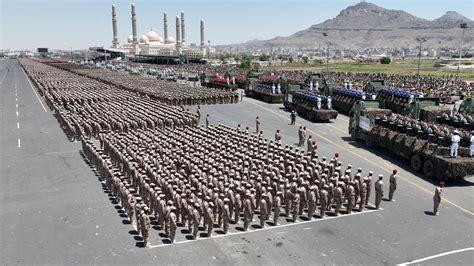
Yemen’s Houthi army emerges as a major threat to Israel and US
Yemen’s Iran-backed Houthi army is emerging as a unique threat to Israeli and American interests — despite being nearly 1,400 miles away from the Israel-Hamas war — as Tehran rallies its allies behind a broader Middle East conflict.
The Houthis surprised the Pentagon last Thursday by launching a string of attack drones and long-range cruise missiles from Yemen that U.S. defense officials say were destined for Israel but intercepted by the USS Carney, an American guided missile destroyer, over the Red Sea. The Houthis have threatened in the past to strike Israel in support of Tehran and its Mideast allies, including Hamas in the Palestinian territories and Hezbollah in Lebanon. But this is the first time they have acted and displayed this long-range capability, said U.S. and Mideast officials who track the Houthis and their military alliance with Iran.
“Let’s be clear that Iran has been increasing the sophistication and lethality of equipment that it’s been providing to the Houthis for years,” said a senior U.S. defense official. “We see demonstrated a pattern of continuing to aid the Houthis, and the Houthis just presented to us some of their capabilities that pose a threat to the region.”
The Houthis now have perhaps the most sophisticated arsenal of ballistic missiles and drones among Iran’s regional allies and proxies, known as the Axis of Resistance, according to Middle East analysts. But the militia’s geographical position makes it a particular threat to global commerce and energy shipments. Yemen sits astride the Bab-el-Mandeb Strait that serves as a choke point for ships entering the Red Sea and the Suez Canal. The Houthis also are in range of the Persian Gulf through which as much as 30% of the world’s oil passes.
The Houthis have displayed in recent years a willingness to strike major commercial targets, particularly in its war against Saudi Arabia and the United Arab Emirates. These operations include the 2019 drone attack on Saudi Aramco’s Abqaiq oil refinery in eastern Saudi Arabia; a January 2021 strike on the UAE’s Abu Dhabi commercial center; and attacks on commercial ships transiting through the Red Sea and Gulf of Aden.
Jay’s view
Tehran has spent decades building its Axis of Resistance, exploiting internal Mideast conflicts and U.S. wars in Iraq and Afghanistan. This network includes Hamas, Hezbollah, and Shiite militias in Iraq and Syria. But the Houthis are unique in that they’ve largely focused on fighting the U.S.’s Sunni Arab allies — Saudi Arabia, Bahrain and the UAE — and have so far been removed from the Arab-Israeli conflict.
The Houthis emerged from southern Yemen as a potent military force in the early 2010s following the toppling of the country’s long-standing dictator, Ali Abdullah Saleh. The militia’s members, who largely adhere to a sect of Shiite Islam, subsequently overthrew Yemen’s Saudi-backed government in 2014 and gained control over much of the Yemeni military’s hardware, including missiles, tanks and air assets. The Houthis used them to gain control over most of northern Yemen in 2016.
Iran seized on Saudi Arabia’s and the UAE’s entrance into the Yemen civil war as a means to bloody two of Tehran’s major regional rivals. Over the past decade, Tehran has smuggled arms to Yemen that have significantly improved the range and precision of the Houthis’ missile and drone systems, allowing for these strikes into Saudi Arabia and the UAE. During this time, the Houthis’ capabilities have advanced in some ways even beyond those of Hezbollah, widely seen as Iran’s most sophisticated proxy force, says Iran analysts.
“The Houthi are the only proxy of the Islamic Republic with both land-attack cruise missiles and medium-range ballistic missiles in their possession, courtesy of Tehran, of course,” said Benham Ben Taleblu of the Foundation for Defense of Democracies think tank in Washington.
Last month, the Houthis staged a massive military parade in Yemen’s capital, Sanaa, which highlighted its capabilities. The show of strength included a test run of a restored fighter jet and new Iranian-designed ballistic missiles with a range of more than 2,000 kilometers. The Houthis also displayed advanced anti-ship ballistic missile systems.
The slogan “Death to America, Death to Israel, Curse the Jews, Victory to Islam” was printed on the side of the jet aircraft in a sign of Iran’s influence.
Room for Disagreement
Biden administration officials are unsure of the Houthis’ willingness to get further involved in military operations against the U.S. and Israel, given what they could lose inside Yemen. The U.S. has been brokering peace talks between the Houthis and Saudi Arabia that has included a military ceasefire that’s held for more than a year. A final agreement would likely cement most of the Shiite militia’s territorial gains over the past decade.
U.S. officials said this week that the Gaza conflict could upend Yemen’s peace process. “My worst fear, of course, is that Yemen gets dragged into another war, and [Yemen’s] war is not over yet,” said the Biden administration’s special envoy for Yemen, Tim Lenderking, on Tuesday at the U.S. Institute for Peace in Washington.
Source » yahoo.com





